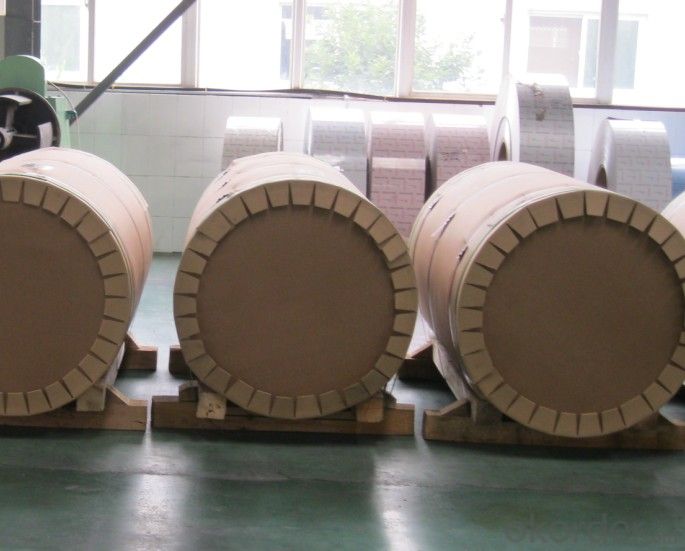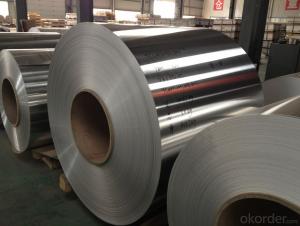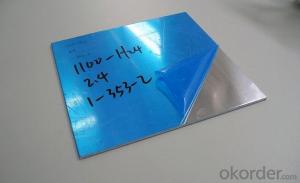Aluminium Cold Drawn Aluminum Slab Stocks In Warehouse
- Loading Port:
- Shanghai
- Payment Terms:
- TT OR LC
- Min Order Qty:
- 2 m.t
- Supply Capability:
- 6000 m.t/month
OKorder Service Pledge
OKorder Financial Service
You Might Also Like
Item specifice
1.Structure of Product Description
Cold rolled aluminum sheet is widely used in the field of construction field and decoration field, etc.
There are many different grades, such as: 1000 series, 2000 series,
8000 series5000 series, 7000series,etc. The detailed grade are as follows: 1010, 1050,1060,1100, 2024, 3003, 3005, 3105, 5052,5754,5083,6061,6063,8011, etc.
The temper is include H14, H22, H24, H44,H112, etc.
2. Main features of the product
a.Competitive price
b.Frist-Class Service.
3. Image.

4.Product detailed sizes:
1000mm*2000mm, 1219mm*2438mm,100mm*3000mm, etc.
5. FAQ:
What is the quality standard?
---Usually our standard is GB3880-2006 or others.
What is the width range?
---It is from 150MM to 2000mm, etc.
What is the length range:
---It is from 600mm to 6000mm, etc.
What is the MOQ for your products yet?
---Normally it is around 7tons/each size.
How many tons did you export in one year?
---Normally it is around 600 tons totally.
Where is your client from?
---Normally it is from Fiji,Turkey, UAE, Saudi Arabia, Japan, USA, England,Canada,etc.
What is your mainly products?
---Normally they are cold rolled and hot rolled and cold drawn aluminum sheet,small-5-bar checkered sheet,big-5-bar checkered cold rolled aluminum sheet, mirror finish aluminium sheet,aluminum sandwich panel, aluminum composite panel,etc.
- Q:Can aluminum sheets be recycled?
- Yes, aluminum sheets can be recycled. Aluminum is one of the most commonly recycled materials in the world because it can be recycled indefinitely without losing its quality. Recycling aluminum sheets involves melting them down to their original state and then shaping them into new sheets or other aluminum products. This process requires significantly less energy compared to producing aluminum from raw materials, making recycling aluminum sheets an environmentally sustainable option.
- Q:How are the aluminum plates cut?
- A little thick with shears or plasma cutting machine, cutting machine words cut out if more smooth, no burr, but the pattern is simple, can be arbitrary cutting plasma cutting machine, but cutting burrs, rough.
- Q:Can aluminum sheets be used for heat sinks?
- Yes, aluminum sheets can be used for heat sinks. Aluminum is a popular material for heat sinks due to its high thermal conductivity, lightweight nature, and affordability. It efficiently transfers heat away from electronic components or devices, helping to dissipate and regulate their temperature effectively.
- Q:What are the different types of surface treatments for aluminum sheets in the marine industry?
- In the marine industry, aluminum sheets are widely used due to their lightweight, corrosion-resistant properties. To enhance the durability and performance of aluminum sheets in marine environments, various surface treatments are employed. These treatments provide an additional layer of protection against corrosion, oxidation, and other forms of wear and tear. Some of the different types of surface treatments for aluminum sheets in the marine industry include: 1. Anodizing: Anodizing is a common surface treatment for aluminum sheets. It involves creating an oxide layer on the surface of the aluminum through an electrochemical process. This oxide layer adds strength, improves corrosion resistance, and can also be dyed to provide aesthetic appeal. 2. Powder coating: Powder coating is a popular method to enhance the appearance and durability of aluminum sheets. It involves applying a dry powder to the surface of the aluminum and then heating it to create a protective coating. Powder coating provides excellent resistance to corrosion, UV rays, and scratches. 3. Chromate conversion coating: Chromate conversion coating, also known as chemical film coating or chromating, involves immersing the aluminum sheets in a solution containing chromate compounds. This process forms a thin layer of chromate conversion coating on the surface, which enhances corrosion resistance and provides a good base for subsequent painting or bonding. 4. Paint coating: Applying a paint coating to aluminum sheets is another surface treatment method in the marine industry. Paint coatings not only enhance the appearance but also provide a protective layer against corrosion, saltwater, and other harsh environmental conditions. Epoxy or polyurethane-based paints are commonly used for marine applications. 5. Mechanical treatments: Mechanical treatments such as brushing, grinding, or polishing can be performed on aluminum sheets to improve their surface finish. These treatments remove impurities, smoothing out any imperfections and enhancing the overall appearance of the aluminum surface. Each of these surface treatments has its own advantages and is chosen based on the specific requirements of the marine application. By selecting the appropriate surface treatment, manufacturers can ensure that aluminum sheets meet the necessary performance and durability standards in the demanding marine industry.
- Q:How do you ensure the surface quality of aluminum sheets?
- To ensure the surface quality of aluminum sheets, several measures can be taken: 1. Cleaning: Before any surface treatment or inspection, it is essential to thoroughly clean the aluminum sheets to remove any dirt, grease, or other contaminants. This can be done with solvents, detergents, or specialized cleaning agents. 2. Visual Inspection: Conduct a visual inspection of the surface for any visible defects like scratches, dents, or pitting. This can be done by trained personnel using proper lighting and magnification tools. 3. Chemical Treatment: Depending on the desired surface finish and application, aluminum sheets may undergo chemical treatments like anodizing, chromate conversion coating, or passivation. These processes can enhance the surface quality, corrosion resistance, and aesthetic appearance of the sheets. 4. Mechanical Polishing: Mechanical polishing techniques such as grinding, buffing, or sanding can be employed to remove surface imperfections and achieve a smooth, glossy finish. Care should be taken to ensure consistency and avoid over-polishing, which can compromise the sheet's integrity. 5. Coating and Protecting: Applying protective coatings like lacquers, paints, or powder coatings can further enhance the surface quality, appearance, and durability of aluminum sheets. These coatings act as a barrier against corrosion, abrasion, and environmental factors. 6. Quality Control: Implementing rigorous quality control procedures throughout the manufacturing process is crucial. This includes regular inspections, testing, and documentation to ensure that the surface quality of aluminum sheets meets the required standards and specifications. 7. Handling and Packaging: Proper handling and packaging during transportation and storage are essential to prevent any surface damage. Adequate protective measures such as using protective films, paper interleaves, or cushioning materials can be employed to safeguard the surface quality until the sheets reach their final destination. By following these measures, manufacturers can ensure the surface quality of aluminum sheets, meeting the desired specifications and customer expectations.
- Q:What industries use aluminum sheets?
- Aluminum sheets are widely used in various industries due to their numerous advantageous properties. One significant industry that utilizes aluminum sheets is the automotive industry. Aluminum is lightweight, yet strong, making it an ideal material for manufacturing car bodies and parts. It helps to reduce the overall weight of the vehicle, thus improving fuel efficiency and reducing emissions. Another industry that heavily relies on aluminum sheets is the aerospace industry. Aluminum's high strength-to-weight ratio makes it suitable for aircraft construction. It is used in the manufacturing of airplane frames, wings, and fuselages. The lightweight nature of aluminum contributes to increased fuel efficiency and allows for larger payloads. The construction industry is also a major consumer of aluminum sheets. Aluminum's corrosion resistance and durability make it an excellent choice for building materials. It is commonly used for roofing, siding, windows, doors, and structural components in both residential and commercial construction projects. In the packaging industry, aluminum sheets are extensively used for the production of beverage cans. Aluminum cans provide a lightweight and portable packaging solution, while also ensuring product freshness and protection from light and air. Furthermore, the electrical industry utilizes aluminum sheets for various applications. Aluminum's excellent conductivity makes it suitable for electrical transmission lines, cables, and wiring. It is also used in the production of heat sinks and electrical enclosures. Other industries that employ aluminum sheets include the marine industry, where it is used for boat building and ship construction due to its resistance to corrosion in saltwater environments. Additionally, aluminum sheets are used in the manufacturing of household appliances, such as refrigerators, ovens, and washing machines, due to their durability, lightweight, and heat conductivity properties. Overall, the versatility, strength, lightweight nature, and corrosion resistance of aluminum sheets make them indispensable in a wide range of industries, including automotive, aerospace, construction, packaging, electrical, marine, and household appliances.
- Q:How strong is aluminum per square inch, and at the same time how light is the aluminum per square inch?
- we have large aluminium sliding doors and in the summer time they twist and will not open why is this.
- Q:As for graphite and aluminum sheet, which one has a better thermal conductivity?
- aluminum sheet
- Q:Can aluminum sheets be easily shaped or bent?
- Yes, aluminum sheets can be easily shaped or bent. Aluminum is known for its excellent malleability and ductility, which allows it to be easily formed into various shapes and bends. It can be manipulated using a variety of techniques such as rolling, pressing, or even using hand tools. The malleability of aluminum makes it a preferred choice in industries such as automotive, aerospace, and construction, where it is commonly used in the production of parts and structures that require complex shapes and bends. Additionally, aluminum's lightweight and corrosion-resistant properties further contribute to its suitability for shaping and bending processes.
- Q:Are the aluminum sheets suitable for manufacturing architectural roof systems?
- Yes, aluminum sheets are suitable for manufacturing architectural roof systems. Aluminum is lightweight, durable, corrosion-resistant, and easy to work with, making it an ideal material for constructing roof systems in architectural projects.
1. Manufacturer Overview |
|
|---|---|
| Location | |
| Year Established | |
| Annual Output Value | |
| Main Markets | |
| Company Certifications | |
2. Manufacturer Certificates |
|
|---|---|
| a) Certification Name | |
| Range | |
| Reference | |
| Validity Period | |
3. Manufacturer Capability |
|
|---|---|
| a)Trade Capacity | |
| Nearest Port | |
| Export Percentage | |
| No.of Employees in Trade Department | |
| Language Spoken: | |
| b)Factory Information | |
| Factory Size: | |
| No. of Production Lines | |
| Contract Manufacturing | |
| Product Price Range | |
Send your message to us
Aluminium Cold Drawn Aluminum Slab Stocks In Warehouse
- Loading Port:
- Shanghai
- Payment Terms:
- TT OR LC
- Min Order Qty:
- 2 m.t
- Supply Capability:
- 6000 m.t/month
OKorder Service Pledge
OKorder Financial Service
Similar products
New products
Hot products
Related keywords



























